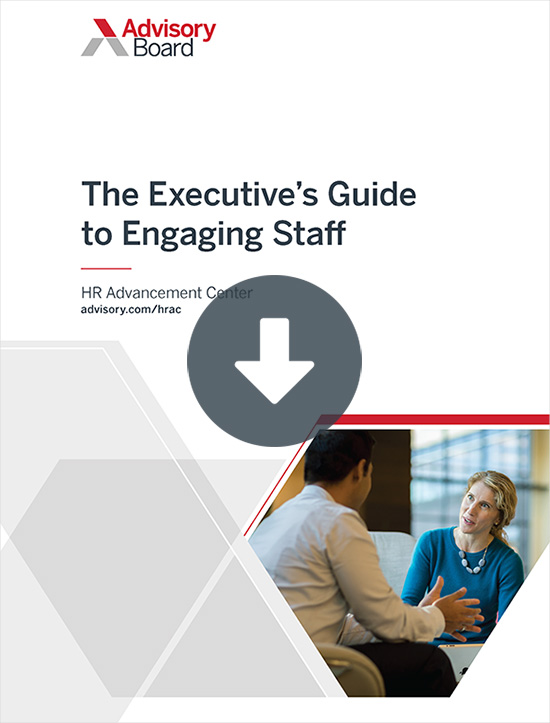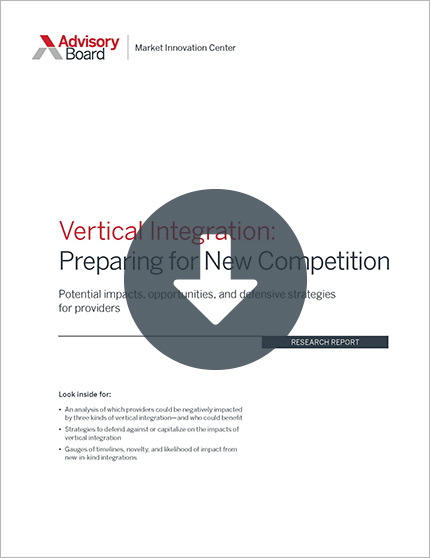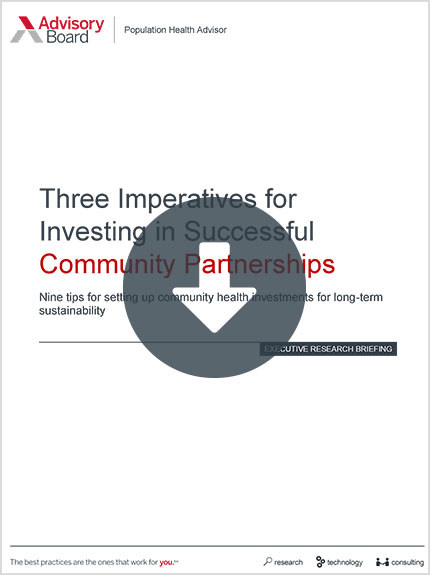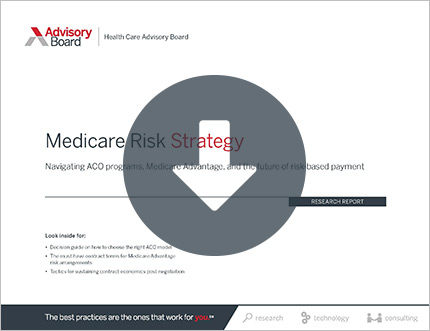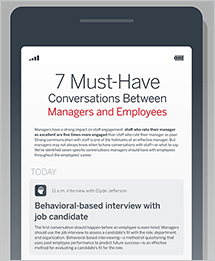Auto logout in seconds.
Continue LogoutWelcome to the "Lessons from the C-suite" series, featuring Advisory Board President Eric Larsen's conversations with the most influential leaders in health care.
In this edition, Brian Gragnolati, president and CEO of Atlantic Health System, talks about his priorities as chair of the American Hospital Association, getting his first role as a hospital president while he was still in his twenties, and how he plans to make Atlantic an "indispensable" system.
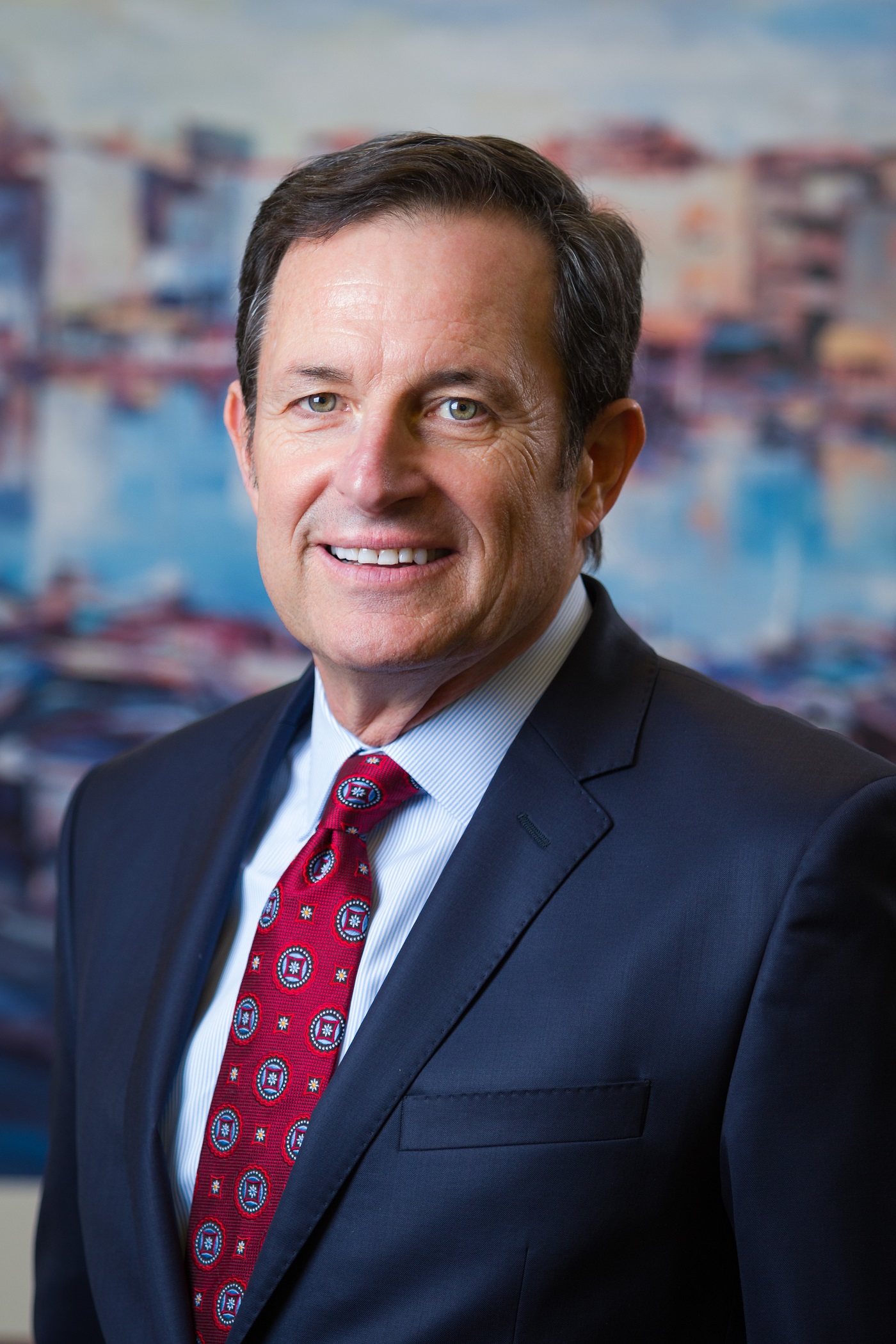
Brian Gragnolati, President and CEO of Atlantic Health System
Question: Brian, you're currently at the helm of Atlantic Health System, serving a market of 4.9 million people across 400 sites of care in New Jersey, and concurrently serving as chair of the American Hospital Association's (AHA) Board of Trustees.
Before we discuss your strategy around advancing vertical integration for Atlantic, as well as your perspectives and insights as AHA chair, I'd like to start by asking about your background—you had the unique experience of growing up as the son of a local politician in Connecticut. I understand that had an outsized influence on your subsequent career course.
Brian Gragnolati: Yes, certainly it did. When you're the son or daughter of a politician, you get exposed early on to service. That was really the primary motivation for my dad—figuring out how he could serve his community or state in a different way. So that taught me a lot about having a sense of service and purpose in your work, but there are also a lot of sacrifices along that path, particularly for families.
You know, my father couldn't make it to all my soccer games. Money was another trade-off—my parents gave me as much as they could for college, $500 a year, but I had to figure out the rest.
Q: That insight into your background, Brian, I think may explain what was going to be my next question—asking about the wide array of different jobs you've had across your career. You worked as an EMT, as a Resident Assistant at your college, and I believe you at one point along the way launched a roofing company.
Gragnolati: Yes, Eric, exactly. I think when you have to fund your college education, you have become pretty entrepreneurial and flexible about what you do—and you have to have a good, solid work ethic because you're always doing something. There's not a lot of downtime. Figuring out how to balance all that stuff and be effective is a skill I've used throughout my career.
And really, all the things I did in college helped my career. After getting introduced to health care through my work as an EMT, I moved into the health administration track in the school of business. And as a Resident Assistant, I learned a lot about service and how to moderate a really diverse environment—we didn't allow frats on campus, so we had ROTC Rangers, hippies, and everyone in between living together in the dorm. That experience was integral in learning how to collaborate with people who are different than you, a critical skill in health care.
I actually ended up doing an internship at Baystate Medical Center because that was near where I lived while managing my small roofing and window replacement company. In fact, I ended up working there right out of undergrad as a management engineer.
Q: You earned your first job as Hospital President—if only on a temporary basis—when you were still in your 20s. Talk about that development if you would.
Gragnolati: After Baystate, I took a job at what was then called Medical Center Hospital of Vermont (now Fletcher Allen Health Care). Part of my job was working as a liaison with various referring facilities, and during that process, I spent eight months part-time at one of the referring hospitals in New York state, Moses Ludington. When the CEO of that hospital left unexpectedly, I was asked to step in while they figured out how to recruit another CEO to a very rural facility.
Q: Trial by fire.
Gragnolati: Exactly. I was about 28 or 29, and literally the day I got there, among myriad other issues, the hospital couldn't meet payroll. I learned a lot. I'd always been at these big, multi-hospital systems, and all of a sudden, I was at a 22-bed rural hospital, with one surgeon and very tough financial circumstances. Over time, we were able to stabilize payments coming in from both Medicaid and Blue Cross, refinance the hospital's debt, and, most importantly, I was able to help the chief nursing officer become the CEO.
A history of vertical integration
Q: From Vermont, you followed one of your mentors, Bruce Bartels, to what was then called York Health System, now WellSpan Health, where he was CEO. I’d like to ask about this because it touches on a theme we'll observe across your health system career—the development of provider-sponsored health plans and vertical integration. You and your colleagues launched the York health plan—can you talk a bit about how that started?
Gragnolati: We couldn't have done it without first establishing Apple Hill, the country's first medical mall, a multispecialty medical group, and a non-risk-bearing PPO, which morphed over time into an HMO. In the process of building those things, I learned a lot about how to enact change while in partnership—when you're trying to weave an ambulatory environment into a traditionally hospital-based structure, you have to figure out how to live in both worlds. Hospitals at the time were the center of the universe, and ambulatory was seen as a threat to the organization, so you had to influence things rather than direct them.
So it boiled down to giving up control to get control, right? And when Bruce recognized that the business community was struggling with their health care costs, he understood that we needed to be part of that conversation—if we weren't, others were going to step in. That's really what created the York health plan. The board was divvied into three parts: the business community; the doctors, who were typically in private practice at that time; and the health system. Together, we developed the health plan capability and did quite well—at its peak, we had about 60,000 covered lives.
Q: It seems you’ve taken this experience and insight forward with you into your subsequent CEO roles, both at Suburban Hospital (Johns Hopkins Health System) and now at Atlantic. At every system, you've engineered some kind of provider-sponsored health plan arrangement.
Here at Atlantic, you've built the Healthcare Transformation Consortium (HTC), a collaborative of New Jersey health systems with self-funded employee health plans. And with the addition of Virtua, I believe HTC is up to around 75,000 lives, employees and dependents, with the platform ready to add more lives down the road. What's the origin story?
Gragnolati: We talk a lot at Atlantic about how to reduce unnecessary utilization while staying viable as an organization, because it's hard to shrink to greatness. So we've focused on how many people we have the opportunity to touch every year and the portion of their care we retain in the system.
Re-ignite the growth engine: 3-part report series
And that's working for us—we're growing; this year we'll have touched about 820,000 individuals in a market of 4.9 million people—but missing from that equation is how to get closer to the premium dollar to begin to mitigate some of those changes. Because you can reduce utilization and increase the number of people you're touching, but we're still predominantly a fee-for-service system.
The constant lament in management meetings was, "Oh, if we could get a piece of that premium dollar." And I finally said, "We have the premium dollar. It's our own workforce. Why don't we figure out how to do that differently?" Because three and a half years ago, when I got here, we weren't even running our self-insured health plan through our ACO. There was this weird divide, for no reason, between our human resources organization and the population health side, but I kept asking why, and we ultimately moved that over.
Q: How did you go about building the infrastructure? Because you did this all—generating the idea, getting all the organizations on board—within a year.
Gragnolati: I knew we needed other voices at the table, because otherwise we'd just end up talking to ourselves. So out of the chute there were two competencies I really wanted in this organization. One, I wanted our marketing and communication apparatus to focus on the future, not the past, so I hired an executive who had little health care experience—her experience was more on the consumer side, and she's done remarkably well.
Second, I hired somebody who came out of the insurance industry, and he's been a home run. He helped us pull together the organizations that joined us in this initiative.
And it was important that we had balanced decision-making in this process. Because like you said, the fact that we came up with this idea, and then expanded the initiative to include six organizations—and we've since added a seventh—and implemented it within a year is nothing short of remarkable in our industry. And key to that process was ensuring that every organization involved has an equal vote, no matter what size it is; no one gets more control because it's a larger entity.
Q: So what's next? What do you see as HTC's natural evolution?
Gragnolati: The next iteration is thinking about how we work with other self-insured employers. And the beauty of doing this within the health care system is that your incentives are pretty well aligned, so you can do really interesting things that benefit your team members.
For example, a lot of our team members commute, some from market areas where one of our transformation partners is located. And since our partners are now in our Tier 1 benefit structure, employees can stay close to home for their care without incurring a financial penalty. So yes, we're giving something up, a certain level of activity in our own organization and encouraging it elsewhere, but it supports something bigger, and it works both ways.
Q: I find HTC interesting because it represents a different-in-kind approach to moving up the value chain and taking on more premium risk. The experience of your peers in directly launching their own health plans has been something of a cautionary tale. As you look out on the industry, both from your CEO post as well as your AHA board chair position, what do you think distinguishes successful from unsuccessful efforts in this area?
Gragnolati: That's a very informed question, and I think about this a lot, Eric. You know, we all are products of our positive and negative experiences. For instance, during my time in Pennsylvania, I learned that defining care as "medical loss" created a cultural conflict. Because at that point in time, the notion of having an organization outside your clinical enterprise that viewed care as "medical loss" created an inherent conflict within the organization. So that was one issue.
The second issue is that you really have to know what you're doing. Oftentimes, these efforts are started by people within the traditional health care delivery organization who don't understand how insurance companies work. And that's why here at Atlantic, it was so important for me to bring somebody in who actually understood the health insurance business—not because we have any plans to launch a health care insurance company, but because understanding that point of view and imbuing how we conduct business with that awareness is really important.
Third, there are a number of provider-owned health care companies that are also health care insurance companies that are doing well, but most have that same characteristic: They've been at it a long time. There are things called insurance cycles, and you've got to learn how to live through them. And a lot of people abandoned ship at various periods of time, so I think that the companies that are in play now are doing well and built to last.
Q: Let’s juxtapose HTC for a moment with another health system partnership you participate in: AllSpire Health Partners. AllSpire was launched in 2016 with five other health systems (including Tower, WellSpan, Lehigh Valley, and Hackensack Meridian) with the ambition to build GPO efficiencies and address clinical/cost improvement initiatives. I'd like to hear your perspective Brian, again as AHA chair and health system CEO, because while many of these non-equity collaboratives nationally have struggled, AllSpire seems to have notched some wins.
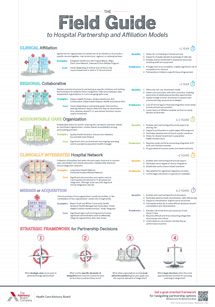
The field guide to hospital partnership and affiliation models
Gragnolati: AllSpire was a bit of a different play than HTC. AllSpire was in place before I got here, but it made a lot of sense to me because it brought organizations together to focus on saving money. A good example of that is the GPO you mentioned, as well as an initiative we're doing with a common pharmacy benefit manager and some data-sharing initiatives we're working on, particularly around quality and best practices.
Really, the difficulty with AllSpire going forward is figuring out what to do next, because, since we're in two states, we run into the intrastate issue, so there's some discomfort about what you can do together. Overall, though, growth is the key here—how do we grow that organization? That's really what we've pivoted to in that conversation. But your perspective about doing those types of collaboratives is accurate. I do think that they do have a value in saving costs, but what happens beyond that is an open question.
Creating an 'indispensable' system
Q: I'm glad you mentioned growth, Brian, because I'd like to ask about your strategy here. Atlantic has its own geographic and strategic niche in New Jersey, distinct from what Hackensack Meridian and RWJBarnabas—your two largest competitors in the state—are doing. As you've told me before, you don't wake up every morning saying, "I'm going to be the biggest health system in New Jersey—I just want indispensability in my market." What does that indispensability mean to you as CEO of a $3 billion system, surrounded by larger players?
Gragnolati: Indispensability used to be, "You've got sufficient size in the market, so insurers have to do business with you, and therefore you're indispensable." But it's going to be much more nuanced going forward, because patients are increasingly becoming consumers—even those with insurance are feeling more of the pinch of out-of-pocket costs—and the consumer equation is price, access, and the quality of the product you're getting.
Indispensability isn't just going to be your ability to have a contract with an insurer; it's also your relationship with the patient.
Q: And that's driven by how good your product is.
Gragnolati: Right. We've worked very, very hard to perfect our product, and it gets better every year. That's our primary motivation. The questions I ask in every difficult conversation are, "How does it affect our patients in terms of access, quality, and experience? How does it affect our team? And how does it affect our numbers?"—and it's in that order.
The second part of indispensability is trust. How do we conduct our business so that when we touch one of those 820,000 patients, they'll turn to us again? And that gets into brand awareness and how we're perceived in the region.
But it also gets into how we work directly with consumers, and we're tackling two challenges there: One, how to take the friction out of the system so that we're easy to deal with, and two, how to address affordability and excess spending—we have to figure out how to make sure we get people to the right care at the right price.
Q: I can see this perspective underpinning your system redesign—your collaboration with Optum's MedExpress, for instance, operating 12 urgent care facilities together.
Gragnolati: Yes, you can tie this back into something like MedExpress. We used to have a benefit design that incentivized our employees and their dependents to use our emergency departments instead of urgent care, but we flipped that last year. Now, it took a lot of explaining to our team members do that. A common question was, "What do you mean we can't go to the ED for urgent care anymore?" But after the initial shock, it made sense. I call it, "eat our own cooking," because if I'm going to try to sell our approach to an employer, the first thing she'll ask me is, "What do you do with your own employees?"
But that said, if we move care out of the ED and we don't own a piece of the urgent care center, what happens? Fortunately, with MedExpress, we were able to negotiate an ownership interest and a development interest in the market as part of a larger conversation—it took a while, but we're really happy we figured it out. Because that's what indispensability is about—constantly asking ourselves how to provide access to a high-quality product at a lower cost for a consumer.
Q: You've spoken about the need to engage with payers differentially, especially given efforts to eliminate unwarranted care variation while making care more affordable. This works long-term only if you have the payment system to support this transition. And while that doesn't mean that you need to have first-dollar risk, it does mean you've got to have some sort of meaningful shared savings, perhaps including downside risk.
And while I imagine that for your 400,000 ACO lives, the $98 million CMS saved and $43 million earned by Atlantic is considerable, it's probably less than you spent building the infrastructure around that. So, when you sit down with payers, are they receptive around a "total cost of care" framework? Are they open to a downside delegated risk component?
Gragnolati: It varies by payer. You see, one of the challenges in our field is that we tend to gravitate to upside-only activities; so when, under the ACA, they started to pivot to more financial risk, we appropriately get cautious—yet that's where we need to go. But we've got to be purposeful about it, because if we're not, it's very easy to settle back into fee-for-service, volume-based medicine.
And this is where governance matters. I've got to work hard to make sure that our boards understand the hydraulics, because it's clear that we have to drive down per-capita spending in this country. And we have an important piece of that; we are trusted in the health care system, and we need to take the lead on this. But that requires collaboration with payers—it can't be the payer sitting here and the provider sitting on the other side of the table, right? We have to start sitting shoulder-to-shoulder.
Here in New Jersey, we are working hard with Horizon to have those kinds of conversations. As you know, things that have happened here in the past have created some real concern. But our experience with them right now is positive. I am optimistic that Horizon's new leadership is trying hard to partner and work with New Jersey's hospitals and health systems in a different way.
The role of hospital in community
Q: I'd like to ask about the tax situation you inherited—and subsequently resolved—in Morristown, an issue that attracted quite a bit of national attention. This was essentially a debate over whether Atlantic's Morristown Medical Center should have to pay local property taxes; taxes from which it had been exempt as a nonprofit. And ultimately, you and Mayor Timothy Dougherty in 2015 reached a settlement under which Atlantic agreed to pay the town $15.5 million over the course of 10 years, plus an estimated $1.05 million in annual property tax payments between 2016 and 2025.
As you reflect on this several years later, any perspectives to share or lessons learned?
Gragnolati: This isn't the first time in my career that this issue has come up, but I've always found it really interesting, because when a lot of these laws were enacted, hospitals were like pure public charities—there was no Medicare, no Medicaid, nothing. Then and now, we play a very important role in communities.
But times are different; it's my view and the view of Atlantic Health System—while we need tax breaks to support our services, we also need to make fair share payments in our communities, because we do consume resources, and the taxpayer burden is already enormous here in New Jersey. So Atlantic has proactively done this in every community we're in.
Q: How did the Morristown agreement influence that decision?
Gragnolati: I knew I had to deal with it—not retroactively, because that's in the rear-view mirror, but going forward. I was fortunate to be able to go through this process with a great mayor, Tim Dougherty, who truly cares about the people of Morristown and values the many organizations doing business here. I told Tim Atlantic wanted to figure out its fair share, and that's exactly what we did, working together.
The whole thing is rooted in trust, right? Because when Tim and I were talking, there was some statewide legislation that was—and still is—being contemplated, and he asked me what would happen if the issue got legislated. I told him that he would get the best deal regardless—and so far, the deal he and I made is better than what the legislation would provide.
So taking the noise out of that and basing it on our fair share agreement calmed the waters. Now, just because it worked out well in Morristown doesn't mean that it was as easy in every other municipality where we have a hospital, but that's really what we’ve tried to do everywhere.
Q: How does that calculation factor into bad debt and community benefit? Because what I'm hearing you say is that there's a different fair-share payment agreement that you proactively, outside of the Morristown agreement, took to other municipalities. I'm not aware of any other system in the country doing this, are you?
Gragnolati: Yeah, people do it quietly. It's not something that gets shouted from the mountaintops. But, you know, that blue "H" means something significant in every community. We should never lose sight of the fact that hospitals and health systems do things to support our communities that others don't do—because, as true community partners, we are called upon to do more.
Now, not every hospital and health system in the country can do this; it would be unimaginable for those just struggling to keep their doors open. But there are instances where you can reprioritize to address this. Again, it's based on the market and your governance. And here at Atlantic, the governance was very supportive, because they saw the impact of being at an impasse with the local community, and it wasn't helping anyone.
Wrapping up
Q: We can't end our conversation without touching more directly on your work as AHA chair. I know AHA's mandates are advocacy and knowledge transfer, and I know you personally took up the affordability of care as one of your priorities for your tenure—what else are you prioritizing?
Gragnolati: My priorities for my three-year commitment—one year each as chair-elect, as chair, and as past chair—are protecting access to care and insurance, addressing affordability, and the notion of "other voices at the table." What I mean by that is this notion of creating shoulder-to-shoulder relationships to understand how others view things and figure out places where you can work together and learn, because that's where the real power is.
For instance, I'd love to move away from talking about industry disruptors like Amazon-JPMorgan-Berkshire Hathaway, CVS, or Aetna as "us-versus-them." I'd like to think about them as Atlantic Health has done with United and MedExpress; we sat down and figured out how we could collaborate, because bringing more voices to the table will enable us to make better decisions for our communities. As I've had more intimate conversations with other companies, I think they see the same thing. As one senior executive said to me, "We need to work with you guys. We can't do this in isolation either." That's my hope.
Q: You've had a successful career by any measure. As you reflect back, what are you most grateful for?
Gragnolati: I was really fortunate in that several people during my career really helped me out—the first cold interview I had for a job was my internship at Baystate, and I didn't have another until Suburban, more than 20 years later. Every career progression I took during that period stemmed from a relationship I had with somebody, which enabled me to go to the next level.
And because I'm a product of others taking an interest in me and shaping me, I try to give back to our profession through mentoring students, young clinicians and professionals who want to move forward. And it isn't always easy—sometimes you lose good talent because you can't meet their needs in your organization, and they need to progress elsewhere.
As CEO, I face this all the time. On one hand, you want to keep your team together, because the strength of your team is your competitive advantage, but, on the other hand, you have to create opportunities for people. But the funny thing is, especially in health care, you often end up in relationships with those same people down the road, and they grow much stronger over time.
I'm most grateful for how, when I left a particular community or a market, something was better—not because of my individual efforts, but because of the collective efforts of each team I&rsquove had the pretty remarkable opportunity to lead. And that gets back to my dad; figuring out how to get involved and ensuring your additions help improve things.
So that's the most gratifying thing—to this day, I get calls from patients and team members from every place I've been, and they remind me of things we did together. Those calls mean the world to me!
Get more lessons from the C-suite
Check out Eric's recent must-read interviews with top hospital and health system leaders:
Don't call THR a 'hospital system': Inside CEO Barclay Berdan's vision for health care's future
Barclay Berdan, CEO of Texas Health Resources, talks about the ""unprecedented challenge"" he faced just a few months into the job, why he won't call THR a ""hospital system, and how he helped establish the world's largest Blue Zones community—in Fort Worth. Read our interview with Barclay.
'A little bit of a pirate': How Kelby Krabbenhoft built a $6B system—and where he's taking Sanford next
Kelby Krabbenhoft, president and CEO of Sanford Health, talks about the unprecedented CEO-philanthropist partnership behind Sanford's rapid growth, why a successful leader needs to be ""a little bit of a pirate, and the merger that will make Sanford a nearly $6 billion health system. Read our interview with Kelby.
Marc Harrison promised to turn Intermountain into a 'Tesla.' He wasn't kidding.
Marc Harrison, president and CEO of Intermountain Healthcare, talks about Intermountain's recently announced strategic reorganization, previews the launch of a ""virtual hospital"" to better serve rural communities, and shares the surprising worry that keeps him up at night. Read our interview with Marc.
"
Don't miss out on the latest Advisory Board insights
Create your free account to access 1 resource, including the latest research and webinars.
Want access without creating an account?
You have 1 free members-only resource remaining this month.
1 free members-only resources remaining
1 free members-only resources remaining
You've reached your limit of free insights
Become a member to access all of Advisory Board's resources, events, and experts
Never miss out on the latest innovative health care content tailored to you.
Benefits include:
You've reached your limit of free insights
Become a member to access all of Advisory Board's resources, events, and experts
Never miss out on the latest innovative health care content tailored to you.
Benefits include:
This content is available through your Curated Research partnership with Advisory Board. Click on ‘view this resource’ to read the full piece
Email ask@advisory.com to learn more
Click on ‘Become a Member’ to learn about the benefits of a Full-Access partnership with Advisory Board
Never miss out on the latest innovative health care content tailored to you.
Benefits Include:
This is for members only. Learn more.
Click on ‘Become a Member’ to learn about the benefits of a Full-Access partnership with Advisory Board
Never miss out on the latest innovative health care content tailored to you.
